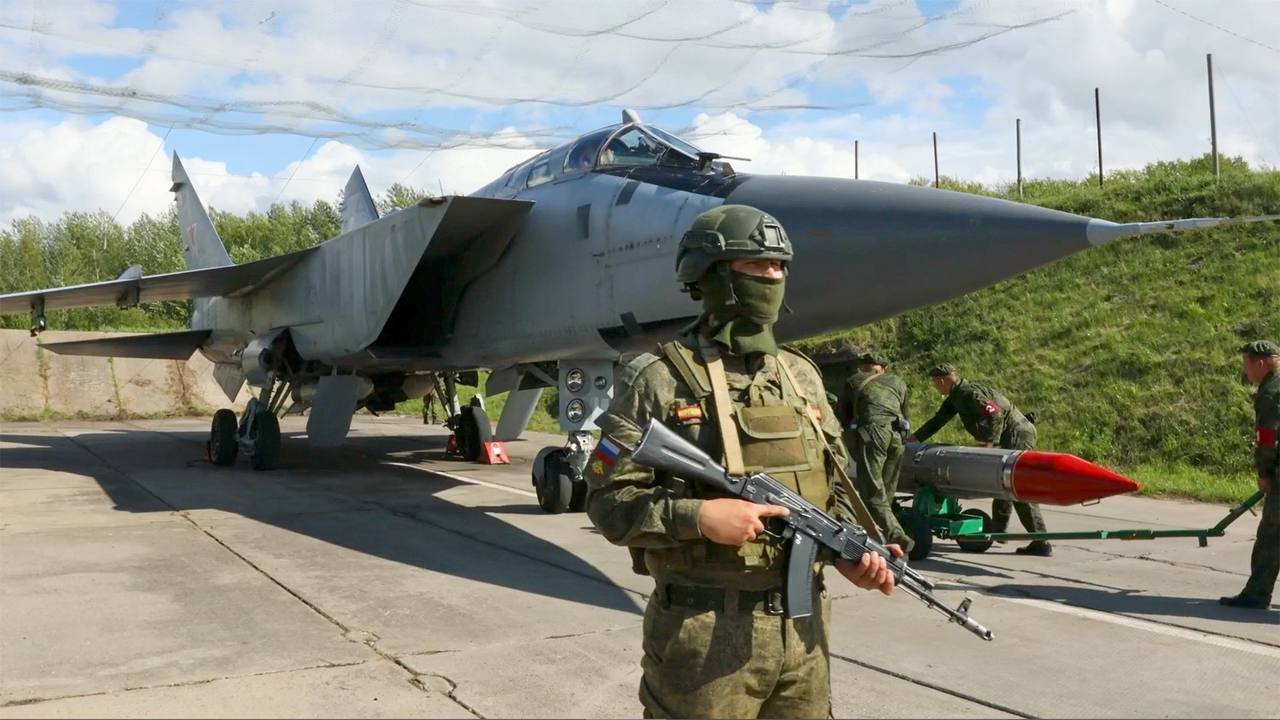The Russian Ministry of Defense (RuMoD) recently released footage showing MiG-31BM interceptors being loaded with long-range air-to-air missiles as part of the third phase of its non-strategic nuclear weapons exercise.
The release of the footage in the context of a training exercise for the deployment and use of tactical nuclear weapons suggests that the missiles could be equipped with nuclear warheads.
The missile being loaded was identified as the R-33 (NATO classification: AA-9 Amos), which is capable of intercepting various aerial targets, including low-flying cruise missiles, at speeds up to 3,000 kph.
R-33 Missile
When initially deployed in 1981, the R-33 missile featured a combination of inertial and SARH (Semi-Active Radar Homing) guidance and had an operational range of 120 km. The Soviet Union developed the missile primarily to take down large high-speed targets such as the SR-71 Blackbird, the B-1 Lancer bomber, and the B-52 Stratofortress.
F-16s “Sitting Ducks” For Russian MiG-31 Fighters? Putin Warns Of Consequences Over Fighting Falcons
Using the R-33, the MiG-31 could target hostile aircraft such as the USAF F-15 Eagle well beyond their retaliation range, which in the early 1980s was under 30 km. The missile featured a conventional 55 kg fragmented warhead.
An improved version of the missile, designated R-33S, featured an active homing warhead.
Zalson Radar
The R-33 was designed to leverage the exceptional performance of the Zalson phased array radar. The radar was a landmark in aviation because it represented the first-ever deployment of a PESA (Passive Electronically Scanned Array) antenna on a fighter aircraft.
The Russian MoD recently released footage showing MiG-31BM interceptors being loaded with (NUCLEAR) long-range air-to-air missiles.
Message for @NATO? #UkraineRussiaWar️️ pic.twitter.com/SyasHEX1lQ
— EurAsian Times (@THEEURASIATIMES) August 4, 2024
Hitherto, PESA radars had only been deployed on the ground or on strategic bombers like the B-1.
A long-range missile needed a radar with long-range detection capability. When initially deployed, Zalson could detect a 16 sq m target at a 200 km range.
Besides long-range detection, the radar features look down, shoot down target engagement, giving the MiG-31 a very credible capability against terrain-hugging cruise missiles. The powerful radar allows six missiles to be guided simultaneously at separate targets.

The R-33 has been significantly upgraded since first entering service. The variant deployed on MiG-31 fighters since 2012 features a range of over 300 km. The missile’s targeting systems have also been improved, allowing it to strike with a greater degree of precision.
The missile travels at speeds of up to Mach 6, making it extremely difficult for even fighter-class target aircraft at extreme ranges to evade. The only major shortcoming of the missile is its size and 500 kg weight, which precludes deployment on medium or light fighters.
The missile continues to remain relevant. Fighters such as the Su-35 and the F-22 Raptor have missile engagement ranges of 130 km and 105 km, respectively, against airborne targets, giving the R-33-equipped Russian interceptor a significant advantage in BVR (Beyond Visual Range) combat.
‘Raptor Salad’ For Lunch! US F-22 Raptor Outgunned, Outmaneuvered By German Eurofighter Typhoon?
Russia has developed a successor to the R-33 called R-37. The export variant of the R-37 is designated RVV-BD. The R-37 uses a dual pulse rocket motor, which makes it very energetic and maneuverable in end-game target engagement.
The R-37 is not just effective against large targets with low manoeuvrability such as bombers, AWACS and aerial tankers, it can also effectively engage a hard manoeuvring fighter aircraft.
Reports have claimed that the R-37 is capable of engaging hostile targets at ranges of 400km.
Nuclear Warhead?
Some Soviet-era air-to-air missiles were known to feature dual conventional and nuclear warhead capability, in alignment with the Cold War era doctrine. However, so far, Russia has never officially acknowledged the existence of nuclear warheads for air-to-air missiles.
The use of nuclear warheads in air-to-air combat is highly improbable in modern warfare.
However, a nuclear warhead may be the only option if adversary EW (electronic warfare) renders ineffective the active seekers of long-range missiles such as the R-33 and R-37.
The US and other allies have an overwhelming advantage over Russia in the number of force multipliers—AWACS, ISR, and refueling tankers—that they can deploy. Russian forces would not be able to hold up against Western forces unless the overwhelming advantage is neutralized.
Forget J-20, China’s H-20 Stealth Bomber Threatens ‘Easy Penetration’ Of LAC; How Can IAF Respond?
If Western EW is able to render Russian missile active seekers ineffective, Russia’s only option would be to launch air-to-air missiles toward the last known target coordinates, relying exclusively on inertial navigation to bring the missiles to the target area and then detonate their nuclear warheads.
The use of air-to-air missiles with nuclear warheads would represent a highly desperate and escalatory measure, but it would be effective.
It’s left to the reader to decide if the footage released by the RuMoD is bluff or caution.
- Vijainder K Thakur is a retired IAF Jaguar pilot, author, software architect, entrepreneur, and military analyst.
- VIEWS PERSONAL OF THE AUTHOR
- Follow the author @vkthakur




